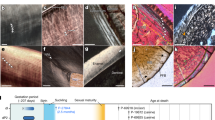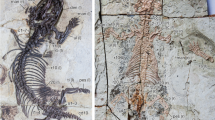Abstract
Placentals are the most abundant mammals that have diversified into every niche for vertebrates and dominated the world’s terrestrial biotas in the Cenozoic. A critical event in mammalian history is the divergence of eutherians, the clade inclusive of all living placentals, from the metatherian–marsupial clade1,2,3,4,5,6,7,8. Here we report the discovery of a new eutherian of 160 Myr from the Jurassic of China, which extends the first appearance of the eutherian–placental clade by about 35 Myr from the previous record, reducing and resolving a discrepancy between the previous fossil record and the molecular estimate for the placental–marsupial divergence9,10,11,12,13. This mammal has scansorial forelimb features, and provides the ancestral condition for dental and other anatomical features of eutherians.
This is a preview of subscription content, access via your institution
Access options
Subscribe to this journal
Receive 51 print issues and online access
$199.00 per year
only $3.90 per issue
Buy this article
- Purchase on Springer Link
- Instant access to full article PDF
Prices may be subject to local taxes which are calculated during checkout



Similar content being viewed by others
References
Kielan-Jaworowska, Z., Cifelli, R. L. & Luo, Z.-X. Mammals from the Age of Dinosaurs: Origins, Evolution, and Structure (Columbia Univ. Press, 2004)
Luo, Z.-X. Transformation and diversification in the early mammalian evolution. Nature 450, 1011–1019 (2007)
Ji, Q. et al. The earliest known eutherian mammal. Nature 416, 816–822 (2002)
Wible, J. R., Rougier, G. W., Novacek, M. J. & Asher, R. J. The eutherian mammal Maelestes gobiensis from the Late Cretaceous of Mongolia and the phylogeny of Cretaceous Eutheria. Bull. Am. Mus. Nat. Hist. 327, 1–123 (2009)
Hu, Y. M., Meng, J., Li, C.-K. & Wang, Y.-Q. New basal eutherian mammal from the Early Cretaceous Jehol biota, Liaoning, China. Proc. R. Soc. B 277, 229–236 (2010)
Rougier, G. W., Wible, J. R. & Novacek, M. J. Implications of Deltatheridium specimens for early marsupial history. Nature 396, 459–463 (1998)
Luo, Z.-X., Ji, Q., Wible, J. R. & Yuan, C.-X. An Early Cretaceous tribosphenic mammal and metatherian evolution. Science 302, 1934–1940 (2003)
Wilson, G. P. & Riedl, J. A. New specimen reveals deltatheroidan affinities of the North American Late Cretaceous mammal Nanocuris . J. Vertebr. Paleontol. 30, 872–884 (2010)
van Rheede, T. et al. The platypus is in its place: nuclear genes and Indels confirm the sister group relation of monotremes and therians. Mol. Biol. Evol. 23, 587–597 (2006)
Kitazoe, Y. et al. Robust time estimation reconciles views of the antiquity of placental mammals. PLoS ONE 2, e384 (2007)
Bininda-Emonds, O. R. P. et al. The delayed rise of present-day mammals. Nature 446, 507–512 (2007)
Phillips, M. J., Bennett, T. H. & Lee, M. S. Y. Molecules, morphology, and ecology indicate a recent, amphibious ancestry for echidnas. Proc. Natl Acad. Sci. USA 106, 17089–17094 (2009)
Benton, M. J., Donoghue, P. C. J. & Asher, R. J. in The Timetree of Life (eds Hedges, S. B. & Kumar, S. ) 35–86 (Oxford Univ. Press, 2009)
Luo, Z.-X., Cifelli, R. C. & Kielan-Jaworowska, Z. Dual origin of tribosphenic mammals. Nature 409, 53–57 (2001)
Liu, Y.-Q., Liu, Y.-X., Ji, S.-A. & Yang, Z.-Q. U-Pb zircon age for the Daohugou Biota at Ningcheng of Inner Mongolia and comments on related issues. Chin. Sci. Bull. 51, 2634–2644 (2006)
Chang, S.-C., Zhang, H.-C., Renne, P. R. & Fang, F. High-precision 40Ar/39Ar age constraints on the basal Lanqi Formation and its implications for the origin of angiosperm plants. Earth Planet. Sci. Lett. 279, 212–221 (2009)
Crompton, A. W. & Kielan-Jaworowska, Z. in Studies in the Development, Function and Evolution of Teeth (eds Butler, P. M. & Joysey, K. A. ) 249–287 (Academic Press, 1978)
Cifelli, R. L. & de Muizon, C. Dentition and jaw of Kokopellia juddi, a primitive marsupial or near marsupial from the medial Cretaceous of Utah. J. Mamm. Evol. 4, 241–258 (1997)
Averianov, A. O., Archibald, J. D. & Ekdale, E. G. New material of the Late Cretaceous deltatheroidan mammal Sulestes from Uzbekistan and phylogenetic reassessment of the metatherian eutherian dichotomy. J. Syst. Palaeontology 8, 301–330 (2010)
Cifelli, R. L. et al. Origin of marsupial pattern of tooth replacement: fossil evidence revealed by high resolution X-ray CT. Nature 379, 715–718 (1996)
Rich, T. H. et al. Early Cretaceous mammals from Flat Rocks, Victoria, Australia. Rec. Queen Victoria Mus. 106, 1–35 (1999)
Martin, T. & Rauhut, O. W. M. Mandible and dentition of Asfaltomylos patagonicus (Australosphenida, Mammalia) and the evolution of tribosphenic teeth. J. Vertebr. Paleontol. 25, 414–425 (2005)
Rougier, G. W. et al. New Jurassic mammals from Patagonia, Argentina: a reappraisal of australosphenidan morphology and interrelationship. Am. Mus. Novit. 3566, 1–54 (2007)
Luo, Z.-X., Ji, Q. & Yuan, C.-X. Convergent dental evolution in pseudotribosphenic and tribosphenic mammals. Nature 450, 93–97 (2007)
Kielan-Jaworowska, Z. & Dashzeveg, D. Eutherian mammals from the Early Cretaceous of Mongolia. Zool. Scr. 18, 347–355 (1989)
Averianov, A. O. & Skutschas, P. P. A new genus of eutherian mammal from the Early Cretaceous of Transbaikalia, Russia. Acta Palaeontol. Pol. 46, 431–436 (2001)
Sigogneau-Russell, D., Hooker, J. J. & Ensom, P. C. The oldest tribosphenic mammal from Laurasia (Purbeck Limestone Group, Berriasian, Cretaceous, UK) and its bearing on the ‘dual origin’ of Tribosphenida. C. R. Acad. Sci. II 333, 141–147 (2001)
Argot, C. Functional-adaptive anatomy of the forelimb in the Didelphidae, and the paleobiology of the Paleocene marsupials Mayulestes ferox and Pucadelphys andinus . J. Morphol. 247, 51–79 (2001)
Asher, R. J., Horovitz, I. & Sanchez-Villagra, M. R. First combined cladistic analysis of marsupial mammal interrelationships. Mol. Phylogenet. Evol. 33, 240–250 (2004)
Kirk, E. C., Lemelin, P., Hamrick, M. W., Boyer, D. M. & Bloch, J. I. Intrinsic hand proportions of euarchontans and other mammals: Implications for the locomotor behavior of plesiadapiforms. J. Hum. Evol. 55, 278–299 (2008)
Acknowledgements
We thank A. R. Tabrum for his meticulous preparation of the fossil, Y.-Q. Zhang for casting, and M. A. Klingler for assistance with graphics. During this work, we benefited from discussion with Y.-Q. Liu on field geology and dating, and with R. J. Asher, K. C. Beard, R. L. Cifelli, M. R. Dawson, T. Martin and J. R. Wible for discussion on mammal phylogeny. J. Wible and M. Dawson helped to improve the manuscript. Support was given to Z.-X.L. from the National Science Foundation (USA), to C.-X.Y. from the National Natural Science Foundation-China and the Chinese Academy of Geological Sciences, and to Q.J. from the 973 Project of the Ministry of Science and Technology of China and funding from the Chinese Academy of Geological Sciences.
Author information
Authors and Affiliations
Contributions
Z.-X.L. and Q.J. designed the research plan. All authors participated in morphological studies. Z.-X.L. and C.-X.Y. performed phylogenetic analyses. Z.-X.L. wrote the paper with discussion from all authors.
Corresponding author
Ethics declarations
Competing interests
The authors declare no competing financial interests.
Supplementary information
Supplementary Information
The file contains Supplementary Text A- M (see Table of Contents) and Supplementary References. (PDF 2973 kb)
Rights and permissions
About this article
Cite this article
Luo, ZX., Yuan, CX., Meng, QJ. et al. A Jurassic eutherian mammal and divergence of marsupials and placentals. Nature 476, 442–445 (2011). https://doi.org/10.1038/nature10291
Received:
Accepted:
Published:
Issue Date:
DOI: https://doi.org/10.1038/nature10291
This article is cited by
-
Zoonotic Cryptosporidium and Giardia in marsupials—an update
Parasitology Research (2024)
-
A century of exercise physiology: concepts that ignited the study of human thermoregulation. Part 4: evolution, thermal adaptation and unsupported theories of thermoregulation
European Journal of Applied Physiology (2024)
-
Derived faunivores are the forerunners of major synapsid radiations
Nature Ecology & Evolution (2023)
-
Middle ear innovation in Early Cretaceous eutherian mammals
Nature Communications (2023)
-
Mandibular and dental characteristics of the Late Jurassic mammal Henkelotherium guimarotae (Paurodontidae, Dryolestida)
PalZ (2023)
Comments
By submitting a comment you agree to abide by our Terms and Community Guidelines. If you find something abusive or that does not comply with our terms or guidelines please flag it as inappropriate.



